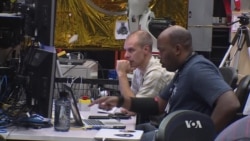The U.S. space agency has its eyes on the future - not just future missions, but the scientists who will plan and carry out those missions. At NASA’s Goddard Space Flight Center outside Washington, a summer internship gives college, post-graduate and high school students a chance to work on projects in a variety of space-related fields. In return, these interns bring enthusiasm and a fresh perspective.
Louis Parent enjoyed working with space robots. The University of Illinois mechanical engineering major is wrapping up his 10-week internship at Goddard, which he calls “probably the best internship” he’s ever had. “They had me work on a real project that really mattered, have some important data that what people do here and really contribute to real science and real engineering.”
Interacting with his mentor and the other interns gave him a better understanding of what he needs in order to pursue a career in this field - a solid background in computer science.
“Computer science isn’t my favorite course to study,” he admitted, “but I finally understood that it’s necessary, and seeing the applications here kind of makes you want to do it more.”
Gaining experience
That sort of transformative experience is a big part of the NASA internship, says Rick Obenschain, Goddard’s deputy director.
“You train somebody here, you give them experiences, you give them enthusiasm, and they’re going to take it with them, whether they stay within NASA or stay in the government or in the industry,” he said.
Obenschain stayed with NASA. He was an intern in 1962, a few years after the space flight center opened in Greenbelt, Maryland.
“We were making small baby steps, which today a student or an intern would say, ‘Wow, this is something that you can do in 30, 40 minutes,'" he said with a chuckle. “Okay, it would take us weeks to figure something out.”
The intern program has evolved a great deal since then. It’s directed by Mablelene Burrell, who proudly says there are more than 400 interns in the program this summer. More than 40 percent are women. “Most of our interns are from the STEM fields. They are engineers, the full range of engineers, from mechanical to electrical. We have many civil engineers, math majors. We have physics majors.”
NASA’s intern programs are crucial to preparing the future workforce, says Robert Gabrys, director of the agency’s Office of Education.
“We define workforce as anybody who would come to work for us, of course,” he explained, “but also who is going to work for one of the contractors who support our space program, or would go and work for a higher institution in a NASA-related field, or become a STEM teacher in a school system.”
Matching projects and interns
The scientists, engineers and technologists at Goddard write descriptions of the projects they want interns to work on, and students apply for the ones that interest them. That helps the researchers identify which students would be the best match for their projects.
Joseph Santanello, who also started his NASA career as an intern, says the students are an invaluable addition to the work environment.
“We get a fresh perspective on how we’re working here, what we’re working on, not just the science part, but generally, how we interact with the community,” he said.
Intern Patricia Lawston has been working with him for the past three summers. She says the internship has been an excellent experience as she pursues a doctorate in climatology.
“Not only the computer resources that I have, but also the connections that I’ve made here,” she said. “It’s really nice coming back for my second and third summers, to walk in the building and see people who recognize and call me by name and to know that any point I can email them and email Joe [Santanello] with any questions I have about my research that’s been very beneficial to me even when I get back to school.”
That ongoing mentoring and collaboration helps the scientists, the students, and the U.S. space program.











